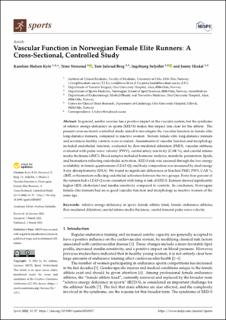| dc.contributor.author | Kyte, Karoline Holsen | |
| dc.contributor.author | Stensrud, Trine | |
| dc.contributor.author | Berg, Tore Julsrud | |
| dc.contributor.author | Seljeflot, Ingebjørg | |
| dc.contributor.author | Hisdal, Jonny | |
| dc.date.accessioned | 2022-08-04T11:57:01Z | |
| dc.date.available | 2022-08-04T11:57:01Z | |
| dc.date.created | 2022-05-23T12:51:00Z | |
| dc.date.issued | 2022 | |
| dc.identifier.citation | Sports. 2022, 10(3), Artikkel 37. | en_US |
| dc.identifier.issn | 2075-4663 | |
| dc.identifier.uri | https://hdl.handle.net/11250/3010158 | |
| dc.description | This is an open access article distributed under the Creative Commons Attribution License which permits unrestricted use, distribution, and reproduction in any medium, provided the original work is properly cited. | en_US |
| dc.description.abstract | In general, aerobic exercise has a positive impact on the vascular system, but the syndrome of relative energy-deficiency in sports (RED-S) makes this impact less clear for the athlete. The present cross-sectional controlled study aimed to investigate the vascular function in female elite long-distance runners, compared to inactive women. Sixteen female elite long-distance runners and seventeen healthy controls were recruited. Assessments of vascular function and morphology included endothelial function, evaluated by flow-mediated dilatation (FMD), vascular stiffness, evaluated with pulse wave velocity (PWV), carotid artery reactivity (CAR %), and carotid intima-media thickness (cIMT). Blood samples included hormone analyses, metabolic parameters, lipids, and biomarkers reflecting endothelial activation. RED-S risk was assessed through the low energy availability in female questionnaire (LEAF-Q), and body composition was measured by dual-energy X-ray absorptiometry (DXA). We found no significant differences in brachial FMD, PWV, CAR %, cIMT, or biomarkers reflecting endothelial activation between the two groups. Forty-four percent of the runners had a LEAF-Q score consistent with being at risk of RED-S. Runners showed significantly higher HDL-cholesterol and insulin sensitivity compared to controls. In conclusion, Norwegian female elite runners had an as good vascular function and morphology as inactive women of the same age. | en_US |
| dc.language.iso | eng | en_US |
| dc.subject | carotid intima-media thickness | en_US |
| dc.subject | carotid-femoral pulse wave velocity | en_US |
| dc.subject | female athlete triad | en_US |
| dc.subject | female endurance athletes | en_US |
| dc.subject | flow-mediated dilatation | en_US |
| dc.subject | relative energy-deficiency in sport | en_US |
| dc.title | Vascular function in Norwegian female elite runners: A cross-sectional, controlled study | en_US |
| dc.type | Peer reviewed | en_US |
| dc.type | Journal article | en_US |
| dc.description.version | publishedVersion | en_US |
| dc.rights.holder | © 2022 by the authors | en_US |
| dc.source.pagenumber | 10 | en_US |
| dc.source.volume | 10 | en_US |
| dc.source.journal | Sports | en_US |
| dc.source.issue | 3 | en_US |
| dc.identifier.doi | 10.3390/sports10030037 | |
| dc.identifier.cristin | 2026504 | |
| dc.description.localcode | Institutt for idrettsmedisinske fag / Department of Sports Medicine | en_US |
| dc.source.articlenumber | 37 | en_US |
| cristin.ispublished | true | |
| cristin.fulltext | original | |
| cristin.qualitycode | 1 | |
